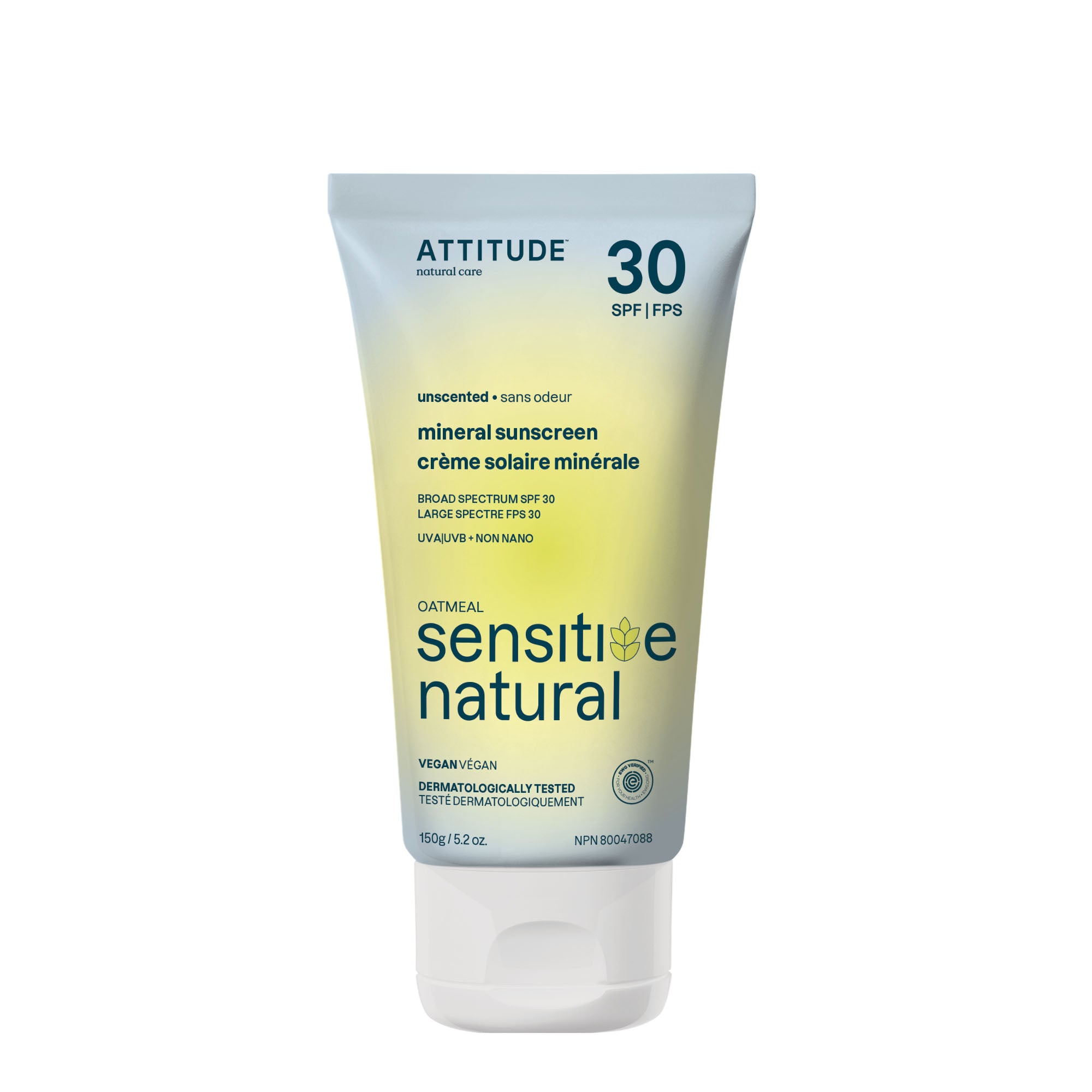Mineral Sunscreen Stick - Spf 30
EWG VERIFIED®
MINERAL FILTER
HIGH PERFORMANCE
Fragrance
Format
Protect your skin with Sunly. ATTITUDE™ SPF 30 sunscreen stick is formulated with nonnano zinc oxide to limit our impact on the oceans. This mineral filter provides broad spectrum protection against UVA and UVB rays. Practical and environmentally friendly, it comes in a biodegradable cardboard tube and applies easily without leaving white traces. Its EWG VERIFIED™, vegan and dermatologically tested formula lets you enjoy your vacation outdoors with peace of mind!
Active ingredient/ Ingrédient actif : Zinc oxide / Oxyde de zinc 20 % Inactive ingredients / Ingrédients inactifs : Vitis Vinifera (Grape) Seed Oil, Caprylic/Capric Triglyceride, Cocos Nucifera (Coconut) Oil, Helianthus Annuus (Sunflower) Seed Oil, Polyhydroxystearic Acid, Helianthus Annuus (Sunflower) Seed Wax, Behenyl Behenate, Ricinus Communis (Castor) Seed Oil, Mica, Coco-Caprylate/Caprate, Butyrospermum Parkii (Shea) Butter, Glyceryl Behenate, Euphorbia Cerifera (Candelilla) Wax, Capryloyl Glycerin/Sebacic Acid Copolymer, Silica, Methyldihydrojasmonate, Pentadecalactone, Phenethyl Acetate, Triethyl Citrate, Vanillin*, *fragrance (Parfum)
Our products are constantly evolving, hence, please refer to the product packaging for our most accurate ingredient list.
Apply generously 15 minutes before sun exposure. Reapply at least every 2 hours. Use water-resistant sunscreen when swimming or sweating. Read label before use.
Frequently bought with
Frequently asked questions
Our liquid sunscreens are formulated with water and glycerin base, while our plastic free sun sticks contain oil, butter and wax. Our liquid sunscreens have a texture that provides a moisturizing feeling to the skin, while our sun sticks are more nourishing.
To choose the right sun product for your needs, it is important to consider your skin type. People with dry skin or those looking for more nourishing protection may prefer our sun sticks, while those with oilier skin may prefer our liquid sunscreens.
SPF indicates the amount of UVB rays blocked by a sunscreen. SPF 30 will block 97.4% of UVB rays, while SPF 50 will block 98%. As you can see, the difference is relatively small. Although the numbers increase, your degree of protection isn’t significantly better. In fact, the difference between SPF 30 and 50 is minimal—SPF 50 only blocks an extra 0.6% of UVB radiation.
Percentage of blocked UVB rays
- SPF 15* 93%
- SPF 30 97,4%
- SPF 50 98%
- SPF 60 98,3%
*Health Canada recommends a sunscreen with a minimum SPF of 15.
And very high SPFs don’t come without risks. They give people the impression that they are extremely well protected, so they tend to spend more time in the sun. However, the SPF value is not a time-dependent protection, but rather indicates the proportion of blocked sun rays. This is why we have to re-apply sunscreen every two hours, regardless of its SPF, to efficiently protect the skin.
For more information, read our article "The Truth About High SPF Sunscreens: Are They Really Better?"
While titanium dioxide is often used in mineral sunscreens, it only provides partial UV protection. Zinc oxide, on the other hand, offers broad-spectrum coverage (UVA and UVB). According to the Environmental Working Group (EWG), zinc oxide is the soundest sunscreen choice.
For an efficient and non-whitening product, it’s important to ensure that there is a high enough concentration of non-nano zinc oxide.
Yes, all our sun care products have a broad-spectrum sun protection factor of 30* and therefore protect the skin against UVA and UVB rays. The zinc oxide that we use in our sunscreen products is considered an excellent component to block UVA and UVB rays effectively.
Also, the best way to protect yourself from UVA and UVB rays is to apply adequate sun protection, wear covering clothing, hats and sunglasses, and limit the amount of time you are in the sun.
*With the exception of our SPF 15 lip balm.
Everyone is exposed to the harmful effects of the sun. However, some people are more vulnerable to the sun’s harmful effects because of their skin type, genetic and hereditary disposition, and their skin’s reaction to the sun. While it is true that very dark skin contains more melanin and has a better defence mechanism than light skin, UVA and UVB rays can have negative effects on all skin types.
Having dark skin can give a false sense of protection from the sun, but beware! Dermatologists therefore recommend using a sunscreen with a protection factor of at least 30 for all skin types.
We have created everyday sunscreens that are non-waterproof. However, we may develop new formulas in the future. Keep your eyes open!
Nanoparticles are tiny molecules that have been nanonized (ground into fine particles). They could therefore enter the body through the outer layers of the skin. There are still many studies to be done to determine the direct impact of nanoparticles on health. But in the meantime, many scientists are playing it safe and not using nanoparticle ingredients in products that come into direct contact with the skin.
In mineral sunscreens, nanoparticles minimize the formation of a white film after application and allow for a more transparent application, which is more appealing to consumers. Sunscreens containing nanoparticles are therefore easy to apply, non-whitening and lighter.
According to the experts at EWG, the safest choice is a non-nano zinc oxide mineral sunscreen to create a physical barrier1.
1.https://www.ewg.org/sunscreen/report/nanoparticles-in-sunscreen/#.WwqMgy8ZNPU
There are two types of UV filters: chemical and physical.
Chemical filters use active ingredients that get absorbed by the skin to block UV rays and protect the skin.
Physical (or mineral) filters create a physical barrier on the skin to block UV rays.
According to the Environmental Working Group (EWG), zinc oxide is considered to be the safest physical filter.




